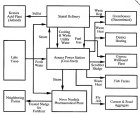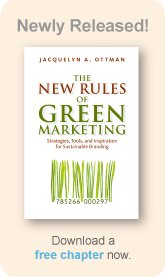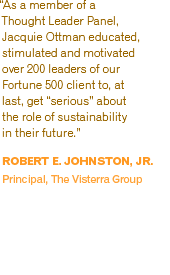Out of the Box and into the Future
By Jacquelyn A. Ottman
Innovation, Spring 2002

1. Integration of toilet and washbasin. The design also facilitates an economical use of water. Designed by Huib van Glabeek, Eindhoven Academy, graduation 1996. Photograph: Hans van der Mars/Hank Visser
If individuals can make a difference, think of the difference individual designers can make. Consider this: a designer in the Netherlands looking to save space in a housing project joined a sink and toilet "at the hip" and accidentally stumbled upon a simple design that would help a family of four save enough water to run their own dishwasher as well as ten of their neighbors’ every day for a year. (Exhibit #1) Not a bad contribution when you realize that by the year 2020, two thirds of all the people on the planet will be living in a water-starved area.
This is one example of "eco-innovation"–developing new products and services that represent functional substitutes for existing products with significantly less impact. And it is just one of the many ways that the global quest for sustainable development presents opportunities for industrial designers to not only make a tremendous difference in the world but to catapult their careers and design consultancies to new levels.
Reinventing the world requires designers to reinvent themselves. The reward: an opportunity to (finally?) contribute strategically to clients’ businesses, since eco-innovation is a great way to uncover new sources of competitive advantage, increase market share, cultivate closer relationships with customers and even redefine the rules by which entire industries operate.
Designers looking to take advantage of these opportunities can use five strategies from our firm’sGetting to Zerosm Environmental Innovation Process.
Set Outrageous Goals. The kind of goals that make people drop their jaws in disbelief. (You want what? When?) Aggressive goal setting forces individuals to shun incrementalism and instead think outside the box for new solutions. Ask: What would we do differently if we had to eliminate waste, water, energy or another environmental impact by a full 100% and still meet the needs of our customers?
If you asked this question about washing machines, for example, you might brainstorm your way from energy- and water- stingy machines and cold water detergents all the way to clothes that get clean in the dryer or even specially treated clothes that don't get dirty at all.
Environmental leaders DuPont and Xerox know the value of setting outrageous goals. Their respective environmental goals are "zero waste," and "waste-free products from waste-free facilities." These aggressive standards have pushed these companies to engineer such innovations as an application for Teflon that prevents men’s ties from getting dirty, and a closed loop remanufacturing system for copiers that has already saved an estimated $300-400 million in materials and parts and diverted millions of pounds of metal from landfills.

2. [chart]. Source: Journal of Industrial Ecology
Think Like a System. Products are not islands unto themselves. All use up resources and eventually wind up as waste. In Denmark, the Kalundbourg industrial eco-system saves millions of dollars inwater, fuel, and landfill costs by recycling waste heat and water and other resources inside this terrarium of an industrial park. (See Exhibit #2) Apply this same thinking to products and watch creative sparks fly. Huib van Gleeb was thinking like a system when he designed the combination basin stand and toilet described above, as were Procter&Gamble when they teamed up with Maytag to develop Tide HE (High Efficiency) to complement Maytag's Neptune ecologically correct washer.
Dematerialize. Meet your customers' needs with as few resources as possible. This suggests opportunities for concentrated products like superconcentrated laundry detergents, as well as for multipurpose products like combination fax/printer/copiers, solar panels integrated into wall siding, shampoos and conditioners-in-one, and many other products.
More significant opportunities for resource efficiency may come from substituting "know-how" and other types of services for material products. For example, knowing what crops to plant next to one another to repel pests naturally can save on the use of chemical pesticides and represents a profitable business opportunity. Volvo has redefined its business from "combustion engine vehicles" to "transportation solutions," expanding their market beyond just the physical product. They are now developing mass transportation systems for China, and global positioning systems to get vehicles and shipments from place to place more efficiently.
A related strategy is to offer "products of service." Car leasing and copier leasing are examples. Seattle’s Flexcar, the largest car sharing service in the U.S., has 2,000 subscribers who pay a monthly fee to time-share a fleet of 60 compact and luxury sedans, vans, and pickup trucks parked around the city. If you drive less than 3,500 miles per year, car sharing can be more affordable and convenient than owning and maintaining a car yourself.
To assess the potential of this strategy for your clients’ business, ask two questions: Do consumers really need to own the product or is leasing an alternative? Can the product's function be equally or better met by a service instead?
Make it Fit. Einstein said, "Make things as simple as possible and no more." Making it fit means positioning the strengths of a product or service most appropriately in the marketplace.

3. Th!nk electric vehicles: "Th!nkbike", "Th!nkCity". New electric vehicles offer a variety of options for getting around the city. Source: Th!ink, Inc. promotion, thinkmobility.com.
Consider the combustion engine vehicle. Rather than trying to produce a single car that can fit the lives of soccer moms, commuting professionals, and single city dwellers, a "portfolio" approach to vehicle production may represent the most economically as well as environmentally sustainable way to go. Th!nk, a new automotive brand from Ford, represents a "portfolio" of electric vehicles more fitted to urban lifestyles: a small "City" commuter car for suburban commuters, and a bicycle assisted by a small electric motor for short hops around town. (Exhibit#3)
Similarly, the answer to the age-old debate about the benefits and pitfalls of cloth versus disposable diapers could be solved through a "make it fit" approach. Since cloth diapers require more water for laundering, families in the Southwest could choose disposables as a lower impact choice, whereas in the East, where water is plentiful but landfills are overburdened, cloth may be the more appropriate option. This strategy also has implications for localized technologies, especially for renewable energies like solar, wind and hydro.
Restore. Current environmental product efforts typically start with a goal of minimizing environmental impact. But the planet’s ecosystems must be restored if we are to achieve global sustainability. A number of businesses have had success developing products that can actually add something back to the environment or society.
?Engelhard’s Premair ozone catalyst, now standard in several Volvo models, actually cleans the air of ozone created by other cars. As air passes through the fins of the cars’ radiator, a catalyst in the radiator coating converts as much as 75% of ruminant ozone to oxygen.

4. Freeplay Wind-up Radio. A human powered radio to help developing communities get access to information networks. Source: Freeplay ENERGY.
In 1994, inspiredby a documentary on the AIDS epidemic in Africa, British designer Trevor Bayliss developed the prototype for the Freeplay Wind-up Radio,which he ingeniously powered by a simple hand crank, clockwork-likemechanism. His goal: help communities gain better access to healthinformation in developing countries, where there are few batteries and no facilities for recycling. (Exhibit #4) Extending the social benefitsfurther, Freeplay was originally manufactured in a South African factory that employs disabled workers. The radio gained popularity amidst of concerns about the "Y2K bug" in the developed world; today it remains a popular accessory for less desperate situations like beach outings and picnics in the park. Implications for Designers
The future lies in the hands of designers and others who can craft elegant solutions to the hefty challenges posed by meeting the needs of an anticipated doubling of the global population within the next generation. In order to adopt a new sustainability paradigm that is emerging, designers will need to do five things:
Think strategically. Ask: what business is our client really in? What benefits do they provide? How can we help them best "package" their expertise?
Forge a new role for industrial design, from "maker of products" to "fulfiller of human needs." Consider yourself a designer of services as much as if not more so than just a designer of products.
Approach design from a new perspective. Take advantage of your unique leverage as the intermediary between consumers and technology. Consider the environmental and social impacts and benefits of all of your designs.
Add value and relevance to your designs by transcending corporate borders in the design process and enlisting the support of NGOs and other community stakeholders who can lend a holistic perspective to the project. Also, take advantage of the opportunity to get closer to customers by understanding new needs regarding recycling and disposal.
Start in your own backyard. If the idea of getting involved in sustainable design sounds daunting, start by joining networking sessions and discussion groups on the issues, sharing ideas and information. Consider joining a local chapter of the O2 Global Network of Green Designers, and IDSA’s own Environmental Responsibility Section.
Helpful resources for Green Designers:
O2 global networking group of green designers. www.O2.org.
Also, www.O2-USA.org
IDSA Environmental Responsibility page, http://www.idsa.org/whatsnew/sections/ecosection/
Getting to Zero is a servicemark of J. Ottman Consulting, Inc.
©Copyright 2002 by J. Ottman Consulting, Inc.



 ShareThis
ShareThis
Jacquelyn Ottman is president of J. Ottman Consulting, Inc., a New York-based marketing consulting firm that specializes in helping businesses derive competitive advantage from eco-innovation and green marketing. She is the author of Green Marketing: Opportunity for Innovation, 2nd edition.
Contact Us to learn more about J. Ottman's green marketing services.
Follow Jacquie on Twitter
Read Jacquie Ottman's Green Marketing Blog
Copyright© 2008 by J. Ottman Consulting, Inc.


